In a landmark decision that reverberated across the globe, then-President Donald Trump ordered the United States to withdraw from the World Health Organization (WHO) during the height of the COVID-19 pandemic. The decision, laden with controversy, underscored mounting tensions between the U.S. administration and the international health body, with Trump accusing the organization of systemic failures and bias toward China.
The Trump administration’s decision was rooted in sharp criticisms of the WHO’s handling of the pandemic. Trump accused the organization of downplaying the seriousness of COVID-19 in its early stages and relying heavily on questionable data from China. He also asserted that the WHO failed to hold Beijing accountable for its lack of transparency during the initial outbreak. Calling the WHO “China-centric,” Trump argued that the organization had compromised its mission to protect global health and instead favored the interests of one nation.
Financial concerns were another key factor in the U.S. withdrawal. At the time, the United States was the largest contributor to the WHO, providing nearly $400 million annually, or approximately 15% of its budget. Trump contended that American taxpayers should not be funding an organization that, in his view, had failed to act in the best interest of global health. Instead, he suggested that those funds could be redirected to other health initiatives or domestic priorities.
The announcement drew swift backlash from public health experts, global leaders, and many within the U.S. itself. Critics warned that withdrawing from the WHO during a global pandemic was a short-sighted move that could undermine international efforts to combat COVID-19 and other health crises. They argued that global health threats require collective action and that the U.S.’s absence from the WHO would weaken its influence in shaping international health policies.
Despite the criticism, Trump’s decision was met with support from some circles, particularly those who shared his concerns about perceived inefficiencies and accountability within the WHO. Proponents of the withdrawal believed it sent a strong message about the need for reforms within the organization.
Under the WHO’s rules, a member state’s withdrawal requires a one-year notice period, and outstanding financial commitments must be settled. This meant the U.S. exit would have officially taken effect in July 2021. However, the decision was reversed by President Joe Biden shortly after he took office in January 2021. Biden signed an executive order to rejoin the WHO, signaling a renewed commitment to global health cooperation.
This contentious episode highlighted the complexities of global health governance and the challenges of balancing national interests with the collective needs of the international community during a crisis.
U.S. Withdraws from WHO Under Trump: A Controversial Move Amid a Global Pandemic
